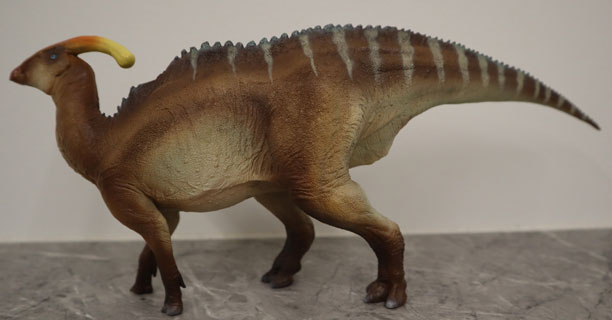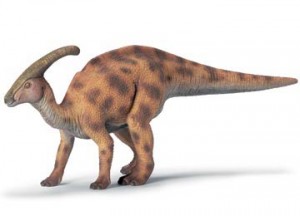Dinosaur Colours and Camouflage Examined in Research
The Bright and Colourful Mesozoic
In the past, many scientists thought that dinosaurs were uniformly grey and drab, perhaps influenced by the relatively plain colouration of large land animals today such as elephants, rhinos and hippopotamuses (although hippos can turn a fetching shade of pink under the African sun). Today’s experts believe that the dinosaur world may have been a surprisingly colourful place.
Dinosaur Colours and Camouflage
Dinosaurs were around for a long time before the first flowering plants appeared (the angiosperms), their world was dominated by greens and browns and although the few entirely herbivorous reptiles left today such as Iguanas generally tend to be green and brown in colour, many scientists believe that dinosaurs were brightly coloured. Palaeontologists have cited a number of reasons why many dinosaurs could have been colourful with many skin pigment variations.
Firstly, those fossils that have traces of of skin tissue associated with them indicate that many dinosaurs were covered in scaly skin with some pebble like nodules. These scales could possibly have contained pigment cells which would have provided many dinosaurs with an assortment of colours, perhaps even allowing them to change colour to express emotions or to provide extra camouflage like many lizards today.
The recently discovered and beautifully preserved “mummified” Hadrosaur from Dakota has actual fossilised skin. Close examination of the this indicates that this animal may have had stripes along its tail, a suggestion put forward by Dr Phil Manning of Manchester University who helped study this remarkably well preserved specimen.
To read more about this discovery:
Dinosaur Mummy unlocks Duck-Billed Dinosaur Secrets.
Another reason why dinosaurs may have been brightly coloured is that if they are closely related to birds, then if feathered birds are colourful, why not feathered dinosaurs? As well as providing insulation; protofeathers could have been used in display, they could indicate which animals were reproductively mature. Scientists believe that dinosaurs could see in colour (crocodiles and birds can, so why not their close relatives dinosaurs)?
Many herbivorous dinosaurs lived in herds. The Duck-Billed dinosaurs such as Parasaurolophus could have been stripped in order to make it difficult for a predator to pick out an individual – in the same way that zebras use colours today.
A Model of a Parasaurolophus

PNSO Wyatt the Parasaurolophus dinosaur model in lateral view, a stunning replica of a Late Cretaceous duck-billed dinosaur. The stripes will help to camouflage this herbivorous dinosaur. Picture credit: Everything Dinosaur.
Picture credit: Everything Dinosaur
The picture (above), shows a PNSO Parasaurolophus model: PNSO Age of Dinosaurs.
Communication within the Herd
Also, with animals living in herds there would need to be some way for these creatures to communicate with each other, perhaps colourful crests and patches were used to indicate social status and social order within such herds.
The latest model Parasaurolophus from Bullyland demonstrates this principle. Scientists believe that the crest of this dinosaur may have varied between males and females. The males may have had the bigger crests, some of which exceeded 1.8 metres long. Juvenile Parasaurolophus have little or no crest, perhaps the crest grew as the animals reached maturity. If this is the case then a large crest would perhaps indicate social dominance and status within the herd. This would have been emphasised if the crest was a different colour from the rest of the animal, a bright colour for instance, like orange. This is why the new Bullyland model has been depicted with an orange coloured crest.
The Bullyland Model Parasaurolophus (Orange Crest)

Picture credit: Everything Dinosaur
The model depicts a male Parasaurolophus with a distinctive and large head crest.
A Picture of a scale Model – Parasaurolophus
Picture credit: Everything Dinosaur
To view the model: Dinosaur and Prehistoric Animal Models.
The orange strips may have helped camouflage this animal as it moved through woodland (helping to break up it’s body outline). Stripped animals moving in a herd are also given a degree of protection as the colour scheme can prevent a predator from selecting an individual to attack.
There are a number of interpretations available regarding the colouration of dinosaurs. Fossils can reveal a great deal of detail about these ancient creatures but they rarely include any signs of the skin. The softer body parts usually rot away before preservation and things like colouration do not normally fossilise. This means that scientists can speculate as to the actual colour of dinosaurs and as a result many variants have been put forward.
The Parasaurolophus from German model makers Schleich is depicted with a very different colouration. In this model, a leopard like spotted coat is favoured. Palaeontologists using evidence from Alberta believe that this animal may have favoured woodland environments. Spots as well as stripes would have made good camouflage. Hence in this instance, Parasaurolophus is depicted as having a spotted coat.
Another View of the Parasaurolophus Model from Schleich

Picture credit: Everything Dinosaur
To view the Schleich prehistoric animal range and other models: Dinosaur Models and Toys.
The speculation is likely to continue, what is almost for certain is that the grey, drab models of yesteryear will continue to be replaced by more colourful ones. Could be this reflects the latest scientific research, or perhaps it is more to do with appealing to collectors and dinosaur fans.


